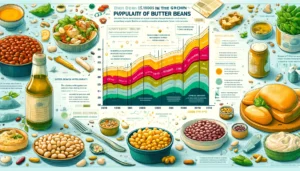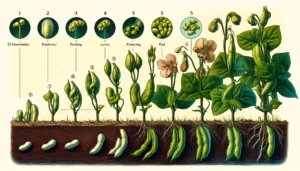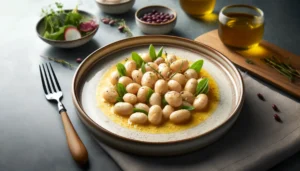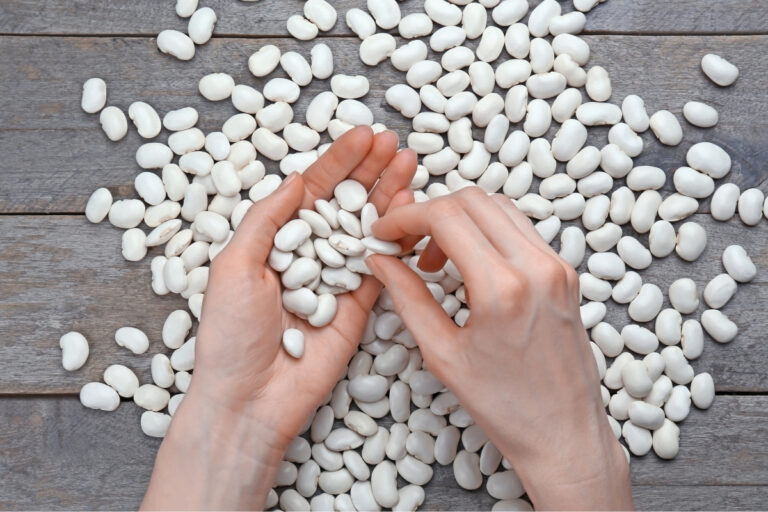Butter beans (B.B), also known as lima beans, are a staple in many kitchens around the globe, known for their creamy texture and versatile flavor. This article dives deep into the world of butter beans, exploring their nutritional benefits, culinary uses, and much more. Whether you’re a seasoned chef or a home cook, understanding how to incorporate these beans into your diet can open up a realm of flavorful and healthy possibilities.
Introduction
Butter beans, with their soft, buttery consistency, are more than just a side dish; they’re a powerhouse of nutrition and a versatile ingredient in the culinary world. Known for their substantial size and pale color, B.B are a type of lima bean that flourish particularly in warmer climates. Their mild flavor makes them an excellent canvas for a variety of spices and herbs, allowing them to be a fantastic addition to many dishes.
What Are Butter Beans?
B.B are the mature form of lima beans, harvested at a stage when they have fully developed in size and nutritional content. Unlike their green, immature counterparts, B.B are dried, which enhances their creamy texture once cooked. This type of bean is celebrated not only for its taste but also for its ability to absorb flavors, making it a favorite among cooks who prize both texture and taste in their culinary creations.
These beans have a storied history, having been a staple in Native American agriculture long before Columbus sailed to the Americas. Today, they are embraced in various cuisines, from Southern American dishes to Mediterranean foods, demonstrating their global culinary appeal. This section will delve into their nutritional makeup and the myriad health benefits they offer, setting the stage for a deeper exploration of how butter beans can be a delightful and healthful addition to meals.
Nutritional Profile
B.B are not only versatile and delicious but also packed with nutrients that can benefit your health in various ways. Understanding the nutritional value of these beans can help you appreciate why they are such a valued addition to a balanced diet.
Health Benefits of Butter Beans
B.B are a fantastic source of essential nutrients, offering significant amounts of fiber, protein, and minerals. Here’s a detailed look at what these beans have to offer:
| Nutrient | Amount per 100g | % Daily Value* |
|---|---|---|
| Calories | 115 kcal | 6% |
| Protein | 7.8 g | 16% |
| Carbohydrates | 20.2 g | 7% |
| Dietary Fiber | 5.5 g | 22% |
| Fat | 0.4 g | 1% |
| Iron | 2.4 mg | 13% |
| Magnesium | 43 mg | 10% |
| Potassium | 508 mg | 11% |
| Folate | 83 µg | 21% |
| Vitamin B6 | 0.1 mg | 6% |
*Percent Daily Values are based on a 2000 calorie diet.
This nutritional setup positions B.B as a powerful plant-based protein source, ideal for those looking to enhance their diet with non-meat protein. Their high fiber content aids in digestion and helps maintain blood sugar levels, making them a beneficial choice for individuals managing diabetes. Additionally, the presence of iron and magnesium promotes healthy blood and muscle function, respectively.
The benefits of incorporating B.B into your diet are manifold. They not only contribute to satiety—helping with weight management—but also support cardiovascular health thanks to their low fat and high fiber profile. Furthermore, the folate in B.B is crucial for pregnant women, as it supports fetal development and helps prevent neural tube defects.
This comprehensive overview of the nutritional benefits demonstrates why B.B are an essential part of a healthy diet, especially for those looking to improve their nutrient intake without adding significant calories. Next, we’ll explore various ways to cook and enjoy B.B, ensuring you can integrate them into your meals not just for their health benefits but also for their delightful flavors.
Rising Popularity of Butter Beans in Global Cuisines
B.B have seen a remarkable surge in popularity across various culinary landscapes over the last decade. This growth can be attributed to their versatility, nutritional benefits, and the rising interest in plant-based diets.
Trend Analysis of Usage
To visually capture this trend, the following infographic illustrates how butter beans have become more prevalent in American Southern cooking, Mediterranean dishes, and vegetarian diets. The graph highlights significant milestones and notable increases in their use, showing a clear upward trajectory in their culinary application.

This infographic provides a clear, visual representation of the data, making it easy to see the growth in popularity of B.B. It’s evident that as more people recognize the health and taste benefits of B.B, their inclusion in recipes and menu items around the world has significantly increased.
Understanding this trend is crucial for chefs and food industry professionals who wish to keep up with current dietary preferences and for home cooks looking to add trendy and nutritious ingredients to their meals. The next section will delve into the culinary uses of B.B, exploring how they can be creatively incorporated into dishes to harness their popularity and health benefits.
Culinary Uses of Butter Beans
B.B are celebrated for their creamy texture and mild flavor, making them an excellent addition to both savory and sweet dishes. This versatility allows them to be used in a myriad of culinary creations.
How to Cook Butter Beans
First, let’s examine the basic preparation methods for B.B, which serve as the foundation for numerous recipes:
| Preparation Method | Description | Cooking Time |
|---|---|---|
| Boiling | Simmer butter beans in water until tender. Ideal for soups and stews. | 60-90 minutes |
| Baking | Combined with aromatics and liquids, baked butter beans absorb flavors deeply. | 90-120 minutes |
| Sautéing | Quick method for tender, canned butter beans. Great for warm salads and side dishes. | 10-15 minutes |
| Slow Cooking | Perfect for breaking down the beans’ structure, enhancing their natural creaminess. | 4-6 hours on low |
Popular Butter Bean Recipes
Now, let’s delve into some popular recipes that showcase the adaptability of B.B in various cuisines:
- Southern Butter Bean Soup:
- A comforting, hearty soup that’s a staple in Southern U.S. cuisine.
- Ingredients include smoked ham, vegetables, and a rich broth.
- Mediterranean Butter Bean Salad:
- Bright, refreshing, and packed with flavors like lemon, olive oil, and herbs.
- Often includes feta cheese, olives, and fresh tomatoes.
- Butter Bean Hummus:
- A creamy, smooth alternative to traditional chickpea hummus.
- Blended with tahini, garlic, lemon juice, and olive oil for a rich spread.
- Vegetarian Butter Bean Chili:
- A robust, flavorful chili that’s both filling and nutritious.
- Combines B.B with various beans, bell peppers, and spices.
- Butter Bean and Spinach Curry:
- A deliciously spiced Indian dish that’s both comforting and healthy.
- Cooked with onions, tomatoes, coconut milk, and aromatic spices.
This table and the accompanying descriptions not only highlight the diversity of dishes that can be made with B.B but also inspire readers to experiment with these beans in their cooking. By incorporating B.B into your diet, you can enhance the nutritional value and flavor of your meals. Next, we’ll explore the differences between B.B and lima beans to clarify common confusions and further expand your bean knowledge.
Growing and Harvesting Butter Beans
Understanding the growth cycle of B.B is essential for anyone interested in gardening or farming these nutritious legumes. Each stage of development is crucial for achieving a successful harvest.
Stages of Growth
The process of growing butter beans involves several key stages, from planting the seeds to harvesting the mature beans. Below is a detailed image that visually represents each stage, providing a clear guide for both novice and experienced gardeners:

- Planting: The journey begins with planting butter bean seeds in well-drained soil during the late spring to early summer, ensuring the risk of frost has passed.
- Germination: After planting, the seeds germinate, sprouting small shoots that break through the soil surface.
- Flowering: As the plants mature, they develop flowers, which are crucial for pod development.
- Pod Development: Following flowering, pods start to form and grow, containing the butter beans.
- Harvest: Once the pods are plump and the beans inside have developed, it’s time to harvest. This usually happens in late summer or early fall.
Understanding these stages helps gardeners optimize their care and attention to the plants, ensuring a bountiful harvest of butter beans. Proper timing and conditions are critical throughout each stage for the best yield. In the next section, we will explore the differences and similarities between butter beans and lima beans, helping you understand more about these related but distinct legumes.
Butter Beans vs. Lima Beans
Often used interchangeably in recipes and conversation, butter beans and lima beans are closely related but have distinct characteristics that set them apart. Understanding these differences can help you choose the right type of bean for your cooking needs.
Understanding the Differences and Similarities
Here’s a table that compares butter beans and lima beans across various attributes to highlight their differences and similarities:
| Attribute | Butter Beans | Lima Beans |
|---|---|---|
| Size | Larger, more plump | Smaller, less plump |
| Color | Generally pale yellow or white | Can be green, yellow, or white |
| Texture | Creamier and starchier | Lighter and less creamy |
| Flavor | Mild, buttery | Milder than butter beans |
| Common Uses | Soups, stews, side dishes | Succotash, side dishes |
| Nutritional Content | Slightly higher in calories and carbs | Slightly lower in calories and carbs |
| Culinary Preference | Preferred in slow-cooked dishes | Often used in quicker cooking methods |
Key Takeaways:
- Size and Texture: Butter beans are notably larger and have a creamier texture, making them ideal for hearty meals where they can be the star ingredient, such as in stews and slow-cooked dishes.
- Flavor Profile: While both beans have a mild flavor, butter beans have a more pronounced buttery taste, which is why they are often chosen for richer, more flavor-intensive recipes.
- Nutritional Differences: Although the differences are slight, butter beans generally provide more energy in the form of calories and carbohydrates, making them a hearty base for many dishes.
- Culinary Uses: Due to their textural differences, butter beans and lima beans fit different types of dishes. Lima beans’ quicker cooking time makes them suitable for lighter, faster meals.
This detailed comparison not only helps in distinguishing between butter beans and lima beans but also assists in making informed decisions about their use in various dishes based on texture, flavor, and cooking requirements. Next, we will explore FAQs to address common questions related to butter beans, enhancing clarity and providing additional insights into their culinary versatility.
Culinary Spotlight: Gourmet Butter Bean Dishes
Butter beans, with their creamy texture and mild flavor, have found a prestigious place in gourmet cuisine. This part of the article showcases how butter beans are being used in high-end restaurants to create dishes that are as visually appealing as they are delicious.
Elevating Cuisine with Butter Beans
The image below features a gourmet dish where butter beans are the star. This dish exemplifies how chefs utilize butter beans to add sophistication and depth to their culinary creations. The beans are prepared and presented in a way that highlights their inherent creaminess and subtle flavor, making them a perfect component in refined dining.

This dish is not only a feast for the taste buds but also for the eyes, demonstrating the versatility of B.B beyond traditional home cooking. The elegant presentation underscores the bean’s potential to star in dishes that are served at the highest level of the culinary world.
By incorporating B.B, chefs can create satisfying, nutritious, and innovative meals that appeal to a broad audience. Whether it’s the main ingredient or a complementary side, butter beans bring a luxurious texture and a healthful twist to gourmet food.
Understanding the potential of B.B in fine dining opens up new avenues for exploring plant-based ingredients in upscale culinary settings. Next, we will delve into the FAQs, answering common questions about butter beans to enhance your knowledge and cooking practices.
FAQs on Butter Beans
This section is designed to tackle the most frequently asked questions about B.B, providing clear and concise answers that help demystify various aspects of these versatile legumes.
Common Questions About Butter Beans
Here’s a table that organizes these FAQs into an easy-to-read format, making it simple for readers to find the information they need quickly:
| Question | Answer |
|---|---|
| What are the health benefits of eating butter beans? | Butter beans are a great source of protein, fiber, and essential nutrients like iron and magnesium, which support overall health. |
| How do you cook butter beans? | Butter beans can be boiled, slow-cooked, or canned. They need to be soaked overnight if dried, then simmered until tender. |
| Can butter beans be eaten raw? | No, butter beans contain lectins that can be toxic when raw and must be cooked properly to be safe for consumption. |
| What dishes are best made with butter beans? | They are excellent in soups, stews, salads, and as a meat substitute in many dishes due to their creamy texture. |
| How do you store butter beans? | Dried butter beans should be stored in an airtight container in a cool, dry place, while cooked beans can be refrigerated for up to five days. |
| Are butter beans gluten-free? | Yes, butter beans are naturally gluten-free, making them a great option for those on a gluten-free diet. |
| Can butter beans be substituted for other beans? | Yes, their mild flavor and creamy texture make them a versatile substitute in recipes calling for beans like cannellini or navy beans. |
Key Takeaways:
- Nutritional Benefits: Emphasizes the importance of B.B in a healthy diet.
- Preparation and Cooking: Provides essential tips on how to properly prepare and cook B.B to ensure safety and enhance flavor.
- Storage Tips: Offers advice on how to store B.B to maintain their quality and extend their shelf life.
This FAQ section not only serves as a practical guide for those new to cooking with B.B but also enhances the knowledge of more experienced cooks. By answering these common questions, the article aids readers in making informed decisions about incorporating B.B into their meals effectively and safely.
